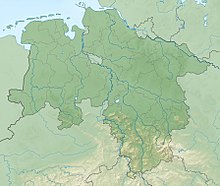Megalithic systems near Westerwanna
Coordinates: 53 ° 45 ′ 8 " N , 8 ° 43 ′ 40" E
The megalithic sites near Westerwanna in the municipality of Land Hadeln in the Elbe-Weser triangle in Lower Saxony are located west of Westerwanna in the moor and in the Süderheide. The megalithic tombs originated between 3500 and 2800 BC. BC in the Neolithic as megalithic systems of the funnel beaker culture (TBK). “Neolithic monuments are an expression of the culture and ideology of Neolithic societies. Their origin and function are considered to be the hallmarks of social development ”.
The hard-to-reach stone graves in the moor are located about 3.5 km west of the village (towards Lüdingworth) in a group of birches.
- Appendix I with the Sprockhoff no. 631 is a well-preserved enlarged dolmen with two capstones measuring 2.5 × 1.3 m. Except for the broken end stone, all bearing and cap stones have been preserved in situ . Stones scattered around the chamber may indicate a very narrow bed of mounds.
- Annex II with the Sprockhoff no. 632 shows only four capstones of the chamber, most of which are in the boggy soil.
- Annex III with the Sprockhoff no. 633 Of the four cap stones in the chamber, only the western one remains. Two more cap stones are still present, as well as seven bearing stones and one end stone.
- Annex IV with the Sprockhoff no. 634 is the remainder of a barren bed, the embankment of which can still be seen at a length of 30 m with a deep burial in the middle. Only a few scattered stones remain from the enclosure and the chamber.
In the past, the megalithic bed is said to have had 24 curbs on each side and an approximately 4.0 × 3.0 m large chamber with an entrance to the south. Around 1900 the stones were transported to Westerwanna to be used in road construction. To the west of the stone graves lies a burial mound in the pastureland.
In the Süderheide of Westerwanna, 600 m west of the village not far from the Postweg, there is a well-preserved passage grave with the Sprockhoff no. 635. All three cap stones, four girders each of the long sides and both end stones are present, even if not all of them are in situ. Four fallen gangways can still be seen from the entrance on the southeast side. The northern capstone has over 20 bowls . The chamber is still surrounded by the considerable remains of the former hill, but its curbs are missing.
In the fields to the east of the passage grave there are considerable barrows. They are the rest of a larger burial ground. During various excavations, findings could be made that suggest Neolithic stone chambers or Bronze Age burials in the hills. But later burials were also carried out on and around the hill: There is no lack of evidence of urn burials from the younger Bronze Age to the Roman Empire.
See also
literature
- Hery A. Lauer: Archaeological Walks Ostniedersachsen Verlag Hery A. Lauer, Angerstein 1979, ISBN 3-922541-08-9 , p. 75ff.
- Ernst Sprockhoff : Atlas of the megalithic tombs of Germany. Part 3: Lower Saxony - Westphalia. Rudolf-Habelt Verlag, Bonn 1975, ISBN 3-7749-1326-9 , pp. 13-15.
Web links
Individual evidence
- ↑ J. Müller In: Varia neolithica VI 2009 p. 15


